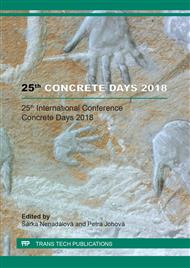p.3
p.9
p.15
p.23
p.29
p.34
p.40
p.45
AAM for Structure Beams and Analysis of Beam without Shear Reinforcement
Abstract:
Advances in technology and sustainability requirements create substantial demand for material research. In construction industry, possibilities of innovation of concrete are opened by using recipes based on new activation methods, where alkaline activated composites can be included. This article focuses on this area where the results of the recipe verified under industrial conditions are presented, and the way of processing is significantly different from the laboratory conditions. The aim of the article is to present the material properties and differences of alkali activated specimens that are compared with series of common concrete material properties based on composition from the same aggregate material base. It was found that the most significant differences are the modulus of elasticity. In both of the recipes, the same design cube compressive strength is used. The article presented also experiment and nonlinear analysis of the alkali-activated beam without shear reinforcement, which was used to study the mechanism of damage and collapse of AAM beam. Nonlinear analysis was used thanks to complex knowledge of material properties. Numerical modelling uses the ATENA software. Test of small structural element is complemented by an advanced crack detection diagnosis with the use of acoustic emission.
Info:
Periodical:
Pages:
3-8
Citation:
Online since:
June 2019
Authors:
Keywords:
Price:
Сopyright:
© 2019 Trans Tech Publications Ltd. All Rights Reserved
Share:
Citation:


